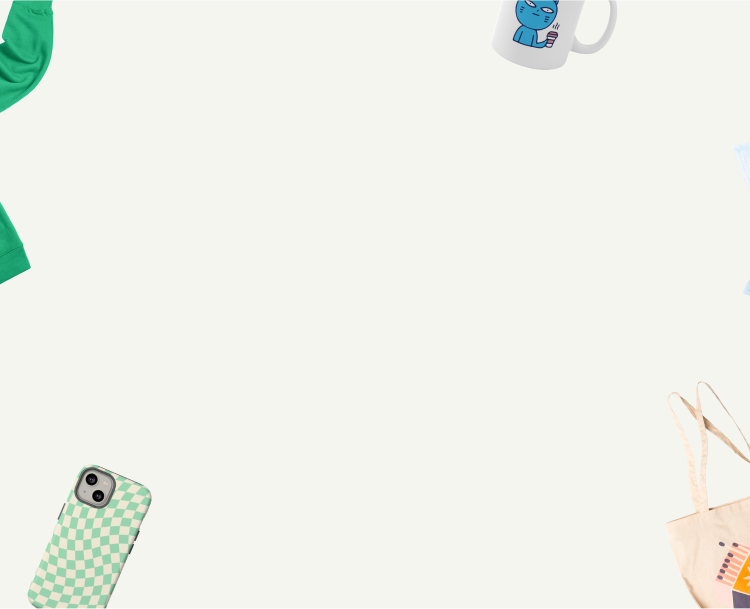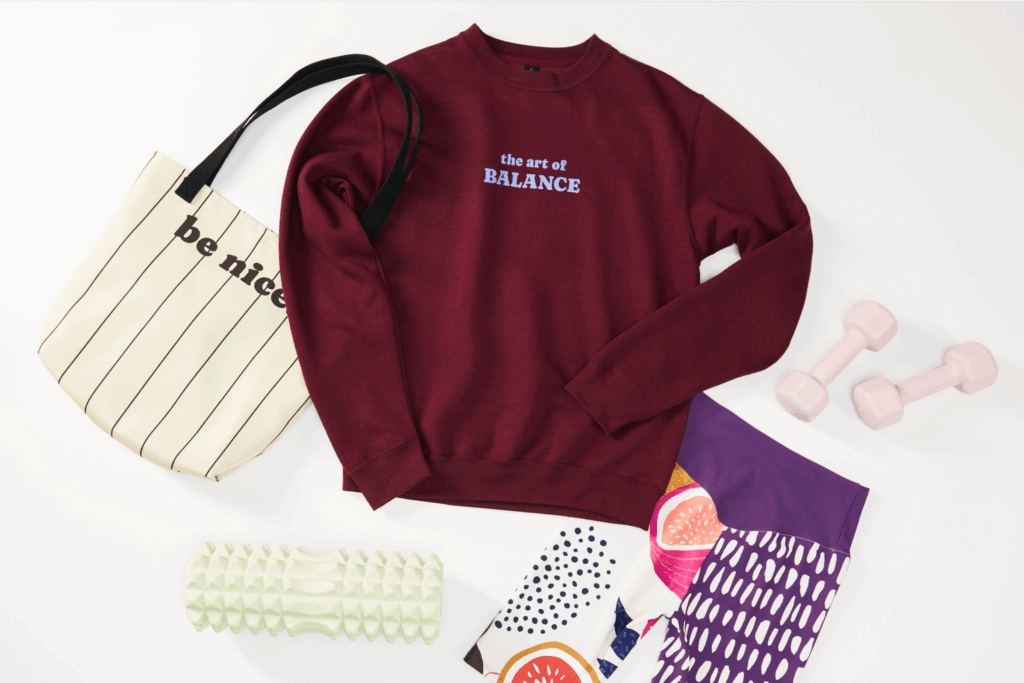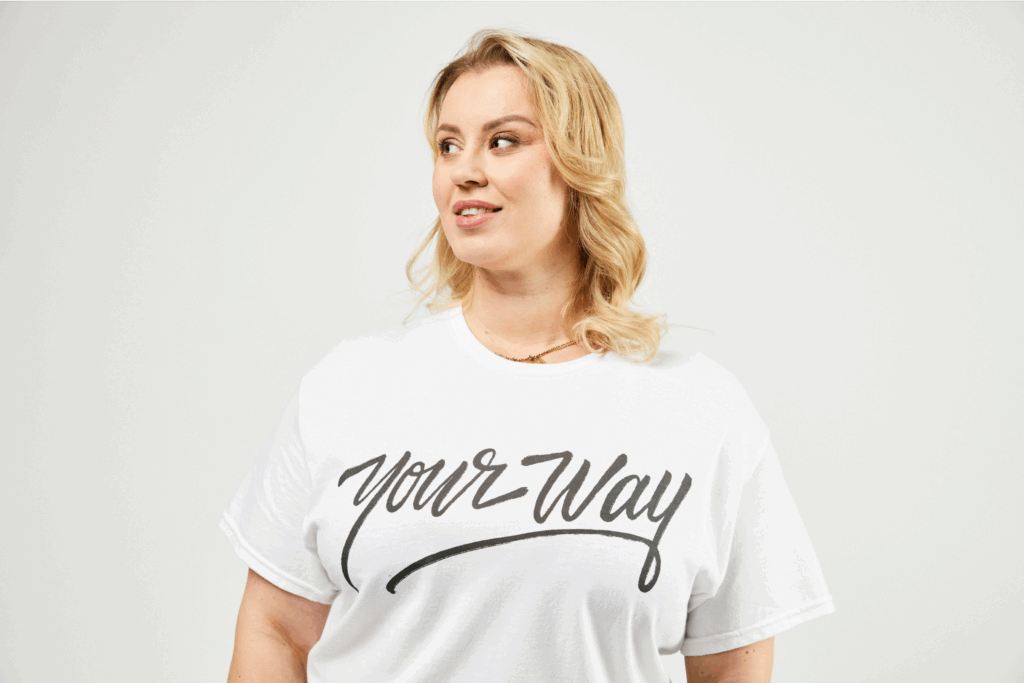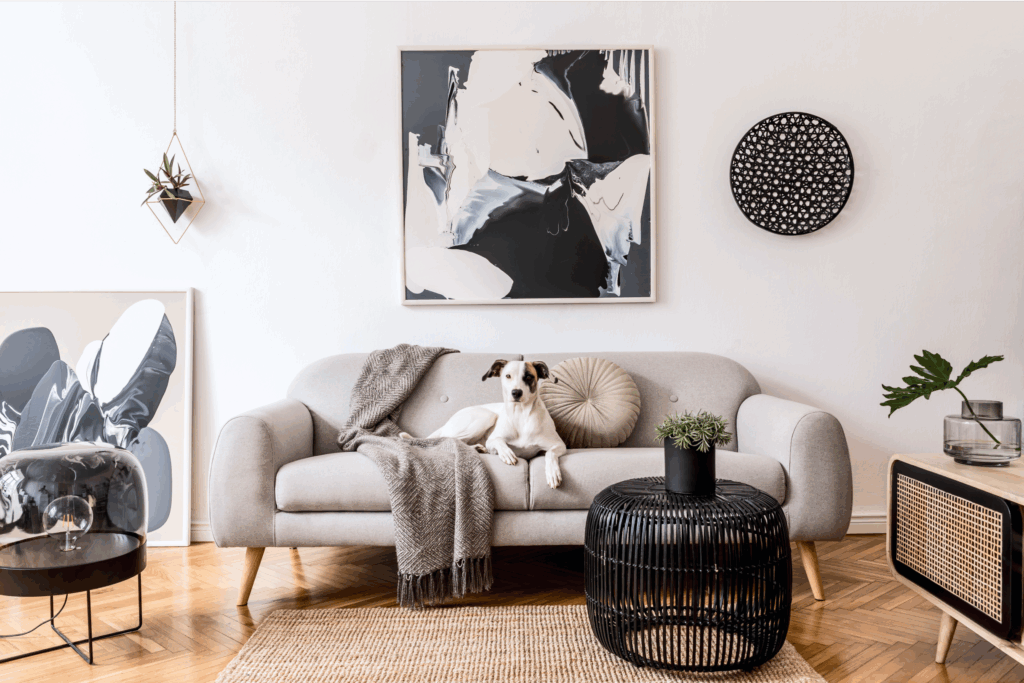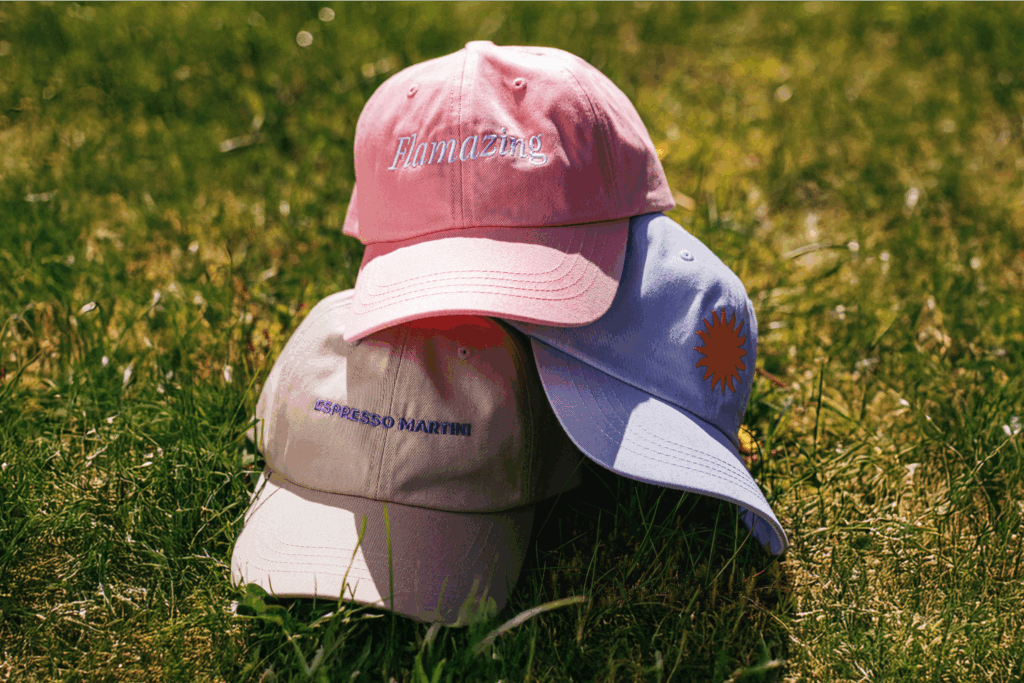Your business, your way – sell with Printify
Wondering how to start your own clothing line? You can launch a reputable brand with high-quality custom merchandise without a physical store or inventory.
This guide will explain how to start a clothing brand step by step. We’ll discuss eCommerce requirements, apparel options, budget-friendly business models, marketing strategies, and expert tips on how to create a fashion brand from home and redefine retail.
Keep reading, learn how to make custom clothes with unique designs, and turn an idea into an eCommerce powerhouse.
This post may contain affiliate links, which means we may earn a commission if you make a purchase through those links. This comes at no additional cost to you.
Use Printify’s FREE product designs
Key takeaways
- Flexible business models: Print on Demand, dropshipping, private-label manufacturing, wholesale, and in-house production each have unique investment and control levels.
- Market research: Thorough market research helps you understand your target market, preferences, and trends.
- Business plan: A business plan based on market analysis, unique selling points, and financial projections will set you up for success.
- Quality and design: Ordering samples lets you check product quality and ensure your unique designs really stand out.
- Storefront setup: There are many eCommerce marketplaces and platforms to choose from for your online store.
- Marketing strategies: Social media, email marketing, and influencer collaborations will help your brand reach more customers.
Why start an online clothing business
Are you questioning whether learning to start a clothing brand is worth it? We believe it is! Here are a few compelling reasons why starting your own clothing brand can be super profitable:
- Low startup costs: Opening an online business requires less upfront investment than a traditional retail store, making it a more accessible option for those with limited funds.
- Flexibility and convenience: Creating an online business has become increasingly hands-off, so you can enter the clothing industry anywhere and anytime.
- Global reach: Having your own clothing company online helps you reach customers worldwide, expanding your market and increasing your sales potential.
- Easy to manage and scale: Online businesses can be managed and scaled more easily compared to on-site ones, helping grow your clothing business efficiently.
The custom clothing market is predicted to reach $78.9 billion by 2027.
The ultimate guide: How to start a clothing brand in 11 steps
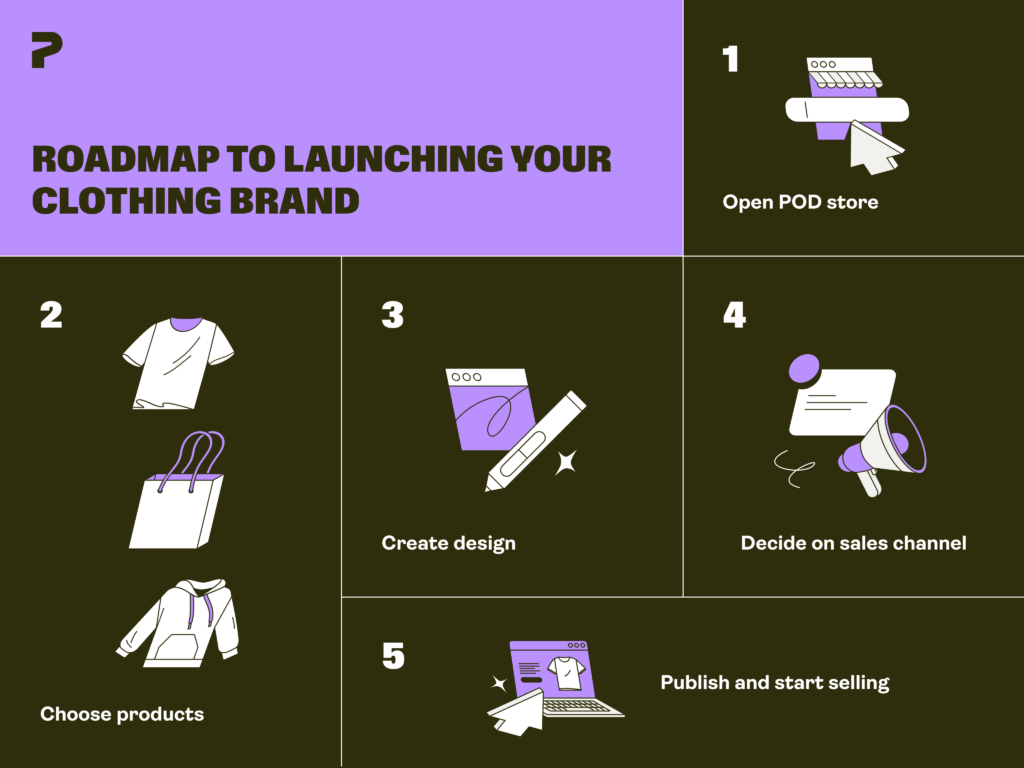
Starting a clothing line can be a rewarding and fulfilling experience. To help you navigate this process, we’ll map out the eleven most important steps you need to take to create a clothing brand.
1. Understand your market
When designing and selling clothing, getting to know your target market always comes first.
This means researching to gain insights into your future customers’ needs, preferences, and purchasing habits. You’ll need to identify opportunities and market gaps to compete with other brands and develop products your target audience will love.
Conducting research before designing your new clothing line will help you make informed decisions and increase your chances of business success.
Here’s what you need to do:
- Identify your target audience: Define who you want to reach with your online clothing store. This could be based on age, gender, location, interests, or income level.
- Conduct surveys and interviews: Contact potential customers and ask them about their clothing preferences and purchasing habits. Use online surveys, in-person interviews, or focus groups to gather this information.
- Analyze market trends: Use tools like Google Trends to research fashion trends and developments and identify market opportunities and challenges. This will help you create clothing items that align with consumer preferences.
- Monitor your competitors: Keep an eye on what your competitors are doing, and pay attention to their products, pricing, marketing, and distribution strategies. This helps differentiate your products from what others are selling and avoid making common mistakes.
2. Select a business model
There are several business models to consider when starting clothing brands. Each model has its pros and cons, and the right choice depends on your goals, resources, and target audience. Let’s review the most common online clothing store business models.
The print-on-demand model
Create custom clothing designs through a POD platform like Printify and list them online on top eCommerce sites like Etsy or Shopify. When a customer orders, Printify’s partners produce and ship the item directly to them. You just have to provide the designs and market your clothing line online.
| Pros | Cons |
|---|---|
| Low startup costs | Limited control over quality |
| Customizable and unique products | Dependence on the POD platform |
| Easy setup | Time and effort in creating designs* |
*If you’re not an experienced fashion designer, you can always take advantage of the Printify x Shutterstock integration or hire an expert to make designs for you.
Dropshipping business
Dropshipping is a safe and hands-off option. Partner with a manufacturer or wholesaler who holds inventory and fulfills orders. When a customer orders from your website, you forward the details to the supplier (for example, AliExpress), who ships directly to the customer.
| Pros | Cons |
|---|---|
| No inventory investment | Lower profit margin |
| Easy to set up and manage | Limited control over fulfillment and service |
| Wide range of products | Dependence on supplier reliability |
Private-label or white-label manufacturing
Work with an existing clothing manufacturer to create your own clothing line. Design from scratch or customize the manufacturer’s products with your brand, then buy in bulk and sell in your online store. This offers higher profit margins and greater control over product quality.
| Pros | Cons |
|---|---|
| Higher profit margins | Requires significant investment |
| Greater control over quality | Less control over product designs |
| Branding opportunities | Strong manufacturer relationships needed |
Selling wholesale
Purchase items in bulk from manufacturers at a wholesale price and sell them on your website for a higher amount. You’ll manage inventory and fulfill orders. This model provides higher profit margins but requires substantial investment upfront.
| Pros | Cons |
|---|---|
| Higher profit margins | Requires investment in inventory |
| Control over inventory | No customization |
| Access to unique products | Risk of unsold stock |
Making your clothing
Design and produce clothing items in-house. This model is ideal for brands wanting to offer unique, high-quality products that reflect personal style and brand identity. It demands significant time and financial investment but allows complete control over the entire process.
| Pros | Cons |
|---|---|
| Complete control over quality | High startup costs |
| Unique product offerings | Must make all clothing by hand |
| Personalized branding | Longer production times |
3. Write a business plan

Even if you’re creating a small clothing business, a thorough business plan will help you gather your thoughts and set you up for success. It’s a written document outlining your business goals, strategies, and action plans.
A well-crafted business plan will help you communicate your vision to potential investors, partners, and customers. It also serves as a roadmap for your fashion business’s growth and development.
Make sure to include these key components in your business plan:
- Executive summary. A brief business overview, including your mission, vision, and primary goals.
- Market analysis. This section should feature detailed research on your target market, including consumer demographics, preferences, and fashion industry purchasing habits.
- Unique selling points. What sets your clothing line apart from your competitors? It could be unique aesthetics, sustainable materials, or a social or environmental mission.
- Production and distribution. Outline your production process, including your sourcing, manufacturing, and logistics strategies. It should also have information about your distribution channels and how you plan to reach your customers.
- Financial projections. This includes revenue, expenses, and profitability, which can all help you understand your online clothing store’s potential financial position.
4. Choose a business name
Your business name is the first thing people will see when they come across your clothing line. To stand out, choose one that’s unique, memorable, and reflective of your brand’s identity.
It shouldn’t be too narrow – for example, a name like Silly Sweatpants might rob you of an opportunity to offer different products as your brand evolves in the future.
Use these tips when choosing a business name for your clothing line:
- Keep it simple and easy to remember. A good business name should be easy to pronounce, spell, and remember. Avoid using complex words or phrases that are difficult to pronounce.
- Be unique. Your business name should stand out from your competitors and be memorable to potential customers. Avoid using generic or common words already used by other businesses in your industry.
- Highlight your brand. It should convey the essence of your brand and what sets it apart from others.
- Check availability. Before settling on a business name, check its availability and trademark status to avoid legal issues.
5. Acquire a business license
A business license is a legal document that allows you to operate your business within the confines of the law.
To obtain a business license for your own clothing line, make sure that you:
- Determine your business structure. Choose a business structure that best fits your business needs and goals, such as a sole proprietorship, partnership, or corporation. This will determine your business’s legal and financial responsibilities and the process for obtaining a business license.
- Register your business. Do this through your local government or state agency, which usually requires you to fill out an application and pay a fee. Creating a legal entity for your business lets you protect your personal assets.
- Get permits and licenses. Depending on your business activities and location, you may need to obtain additional authorizations. This could include licenses for selling products, using certain materials or operating in specific locations.
- Comply with regulations. Ensure that your clothing business complies with all relevant regulations and laws, including taxes, labor, and health and safety. This will help you avoid legal issues in the future.
You don’t necessarily need an LLC (Limited Liability Company) to start your own clothing line or create fashion brand stores, but it can be beneficial for several reasons.
- Liability protection. LLC offers personal liability protection. So, if your clothing brand gets into legal issues or owes debts, your personal assets, for the most part, remain safe.
- Professionalism and credibility. Using an LLC can help customers, suppliers, and potential investors trust your brand more.
- Separation of personal and business finances. An LLC assists in keeping a clear distinction between personal and business-related finances.
Forming and managing an LLC requires some expenses and paperwork. We recommend seeking advice from a legal or business adviser to make the best choice for your circumstances. Operating as a sole proprietorship could be enough since you can shift to an LLC as your business expands.
6. Create unique designs
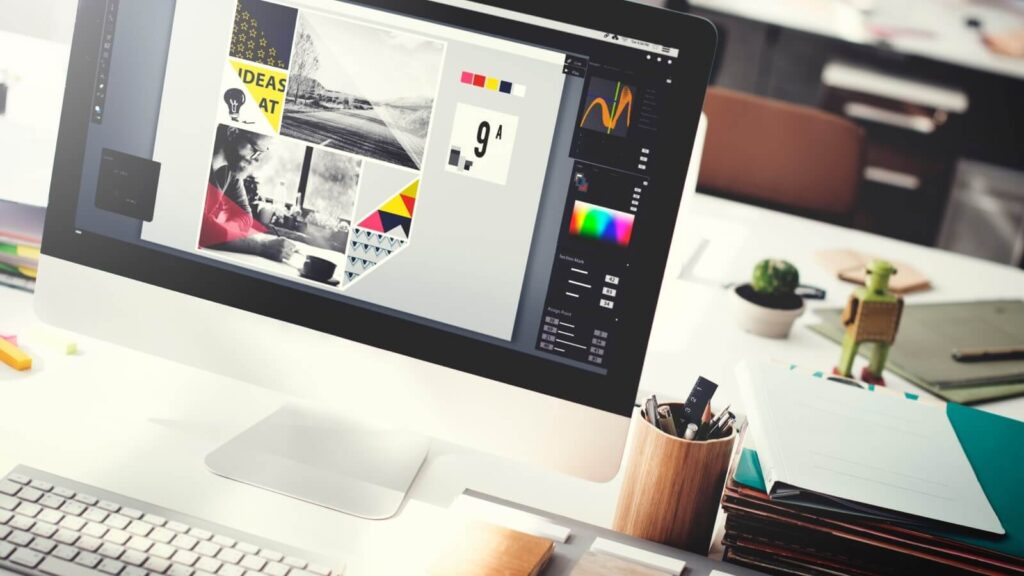
This is a defining step when learning how to start a clothing brand with no experience. Unique designs determine whether you have what it takes to stand out in the crowded fashion market.
Use these guidelines to bring your vision to life:
- Determine your brand’s identity. Define your brand’s unique characteristics, such as its aesthetic, mission, and target audience. This will serve as the foundation for your design process.
- Sketch your ideas. Use pencil and paper to sketch design ideas, or start your illustrations right away with online graphic design software. Experiment, visualize your concepts, make adjustments, and ask for feedback whenever possible.
- Create product mockups. Use the Printify Product Creator or other mockup libraries like PlaceIt to visualize your ideas for products in real life. If you like what you see, save the mockups, which you can later use to prepare products and connect them to your storefront.
- Work with a designer or manufacturer. Collaborate and bring your designs to life with physical prototypes or samples to check for quality and make any necessary adjustments. If you don’t personally know any designers, use a platform like Fiverr to hire a freelance fashion designer to create some art for you.
7. Find a clothing manufacturer
Whenever looking up how to start a clothing brand online, you will always be met with the question of sourcing products. Research different companies and compare their prices and capabilities to see if they’re the best fit for your fashion business.
Follow these steps to find a clothing manufacturer that’ll help you build a successful clothing line.
- Determine your production needs. Identify your production requirements, including the type of clothing you want to produce, the quantities you need, and your desired timeline.
- Research. Look into potential manufacturers by checking different Print Provider ratings in the Printify catalog. Alternatively, use online directories and industry publications or get referrals from other clothing designers in the Printify POD Rockstars Facebook group.
- Order product samples. Once you have identified a few potential manufacturers, order product samples to compare their printing quality.
Printify has a network of over 80 Print Providers in the United States, United Kingdom, Europe, Australia, Canada, and China, giving you the opportunity to sell worldwide.
8. Check the quality of your product
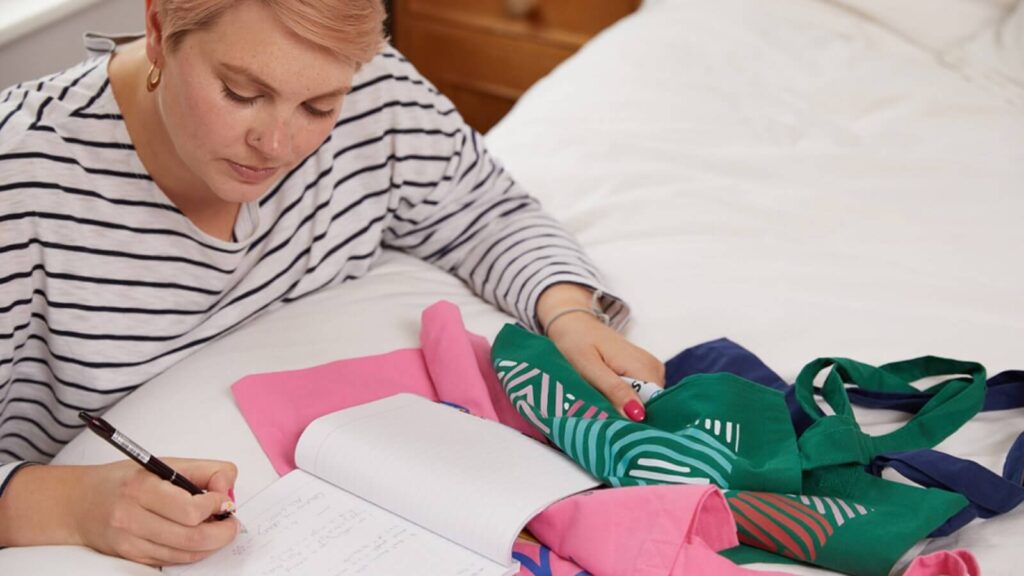
Before selling your clothing, make sure the quality meets your standards.
Order samples to test the durability and fit and ensure the clothing is made with high-quality materials.
Here are some things to check for when evaluating samples for your online clothing store:
- Look for defects. Carefully inspect each piece of clothing for loose threads, misaligned seams, or imperfections in the fabric or printing. This will help you identify and fix any issues before selling your clothing.
- Durability test. Wear and wash the samples to see how they hold up over time. Make sure your clothing is made to last and will meet your customers’ expectations.
- Check the fit. Ensure the clothing fits well and is comfortable to wear. Ask friends, family, or customers to try the samples and provide feedback on the fit and comfort of the clothing.
- Evaluate the materials. Check that the materials are of high quality and meet your standards. This includes the fabric, threads, buttons, and zippers.
9. Choose a sales channel
Choosing a sales channel is a super important step in starting a clothing line, as it determines how you reach your customers and sell your products. There are many different sales channels available, including online marketplaces, eCommerce platforms, and your own website.
Here are the most popular channels for running an online clothing store:
- Online marketplaces. Sites like eBay, Amazon, and Etsy and let you sell your products to a large and diverse audience of potential customers. These marketplaces provide a ready-made platform for selling online but may also have high fees and steep competition.
- eCommerce platforms. Platforms such as Shopify and Wix let you create your own online store and sell your products directly to customers. These platforms offer a range of tools, templates, and features to help you manage and grow your business, but may require a higher level of technical expertise.
- Your own eCommerce website. Creating your eCommerce website from scratch gives you full control of your online presence and customer experience. This can be a powerful way to build your brand and establish a direct relationship with your customers, but it can also require a significant investment of time and resources. Printify’s Custom API will be useful if you decide to go this route.
Ultimately, the right sales channel for your clothing line will depend on your business goals, budget, and target audience. Take some time to research and compare different sales channels to find the best fit for your needs.
10. Price your products right
Pricing your products right is crucial for the success of your clothing line. You need to strike a balance between making a profit and offering attractive prices to customers.
Research your market and competitors to determine a price range that’s fair and viable for your business. When evaluating how much you should charge for your fashion line, the rule of thumb is adding at least 40% on top of the production price.
- Research your market. Determine the demand for your product, the prices of similar items your competitors offer, and the overall price range for your product category.
- Consider your costs. Calculate how much it costs to produce and sell your products, including materials, labor, and overhead expenses. This will help you determine the minimum price you need to charge to make a profit.
- Test different prices. Experiment with different prices to see how they affect sales and customer feedback. You can use online tools or services, such as Optimizely, to conduct A/B testing and compare the performance of different prices.
- Adjust your prices. Monitor the performance of your prices over time and make adjustments as needed. This can include factors such as changes in demand, competition, or operational costs.
- Offer free shipping. Free shipping is an old marketing trick and one of the top buying incentives for shoppers worldwide. Include shipping costs in the product price. Customers are more likely to pay $69 for a custom hoodie than $59 for the product and an additional $10 for shipping.
11. Begin marketing and selling your custom apparel
Drive awareness and interest in your clothing brand using these methods:
- Develop a marketing plan. This plan should outline your goals, target audience, and strategies for promoting your clothing line.
- Build a brand identity. Develop a unique and consistent brand identity that reflects the essence of your clothing line and makes it stand out. This includes elements such as your logo, color palette, tone of voice, and visual aesthetic.
- Engage with your customers. Communicate with your audience via social media, email marketing, and on your website to build relationships and foster a community around your clothing brand identity. This can help you gain insights into your customers’ preferences and needs and drive sales and loyalty.
- Collaborate with influencers. Partner with influencers who align with your brand identity and have a following of potential customers. Influencers can help promote your clothing line to their audience and drive interest.
- Offer promotions and discounts. Encourage customers to purchase your clothing by providing great deals. This can include discounts on your website, special offers for first-time buyers, incentives to increase customer loyalty, or referral programs that reward customers for referring new ones.
Set up Your eCommerce Clothing Business With Printify
How much does it cost to start a clothing line
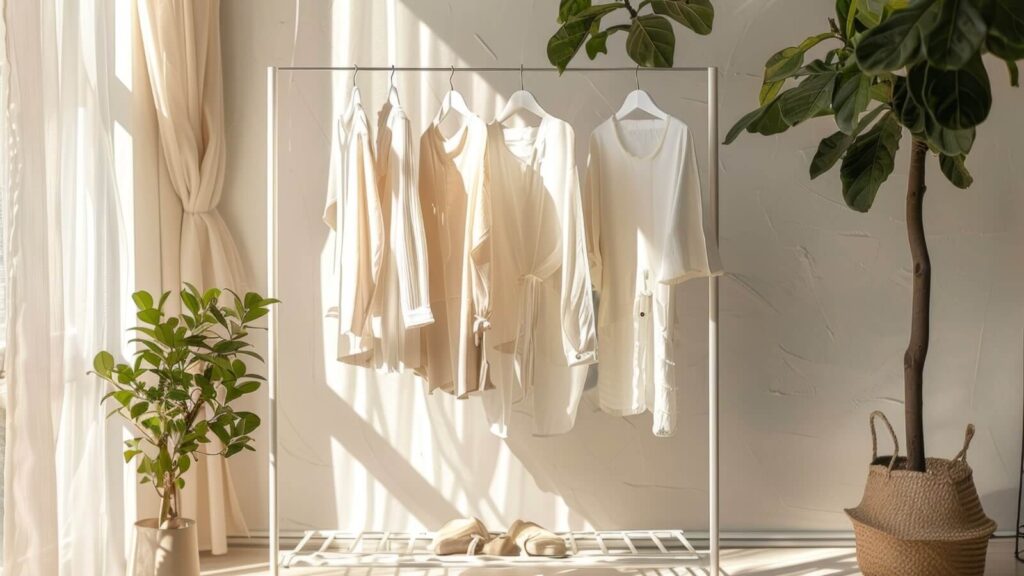
There are many ways to enter the fashion industry, each with different price points. While some require thousands of dollars in upfront expenses, others can require minimal financial investment.
When starting your clothing line business, take these expenses into consideration:
- Hosting fees
- Platform subscriptions
- Inventory management
- Supply logistics
- Employee payroll
- Cost for utilities
- Marketing budget
For those wondering how to start a clothing brand with no money, Print on Demand (POD) is a great option. POD requires minimal upfront costs, as you’re only charged for printing and shipping after a sale is made. This avoids many of the significant expenses related to inventory and supply.
Apart from the print-on-demand model, other less expensive ways to create a clothing line are to purchase wholesale clothing and resell it at a higher price or use dropshipping. More expensive and involved options include white-label manufacturing or starting a fashion brand from scratch.
Join Printify for Free and Start a Successful Clothing Brand With Zero Upfront Costs
Clothing items: What to pick for your fashion brand
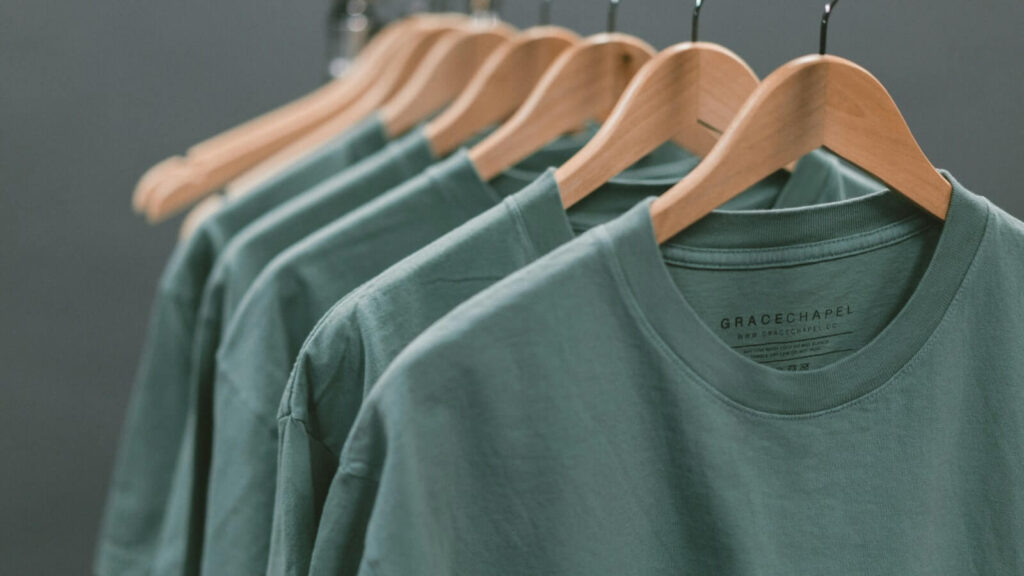
If you’re wondering what to sell, the best and easiest choice is to begin with custom t-shirts. They’re affordable, easy to produce, and have a global reach. Typically, a fashion startup begins its journey with a couple of t-shirt models and then expands to hoodies and beyond.
T-shirts are one the most popular garments in the world. They’re easy to design and sell at high profit margins. With the right custom design, they can earn you big money and really reflect your brand identity.
Use the POD model to expand your product catalog and sell everything from apparel and footwear to hats and accessories. All you need is a great design idea and the right marketing plan.
Athleisure wear, such as leggings and custom hoodies, has become massively trendy in recent years. The global market for athleisure is expected to reach $662.56 billion by 2030, so it’s definitely a style worth considering as you plan your clothing line.
How to start your own clothing brand with no experience using POD
Thanks to Printify, you can bring your clothing business idea to life without investing any money upfront in inventory or production. Follow these steps to start a clothing brand and enter the fashion industry using POD.
Sign up for Printify
Create a free Printify account to get access to over 1,300 customizable products.
Design products easily
Use our beginner-friendly Product Creator to design your own clothing. Add up to ten layers, including photos and graphics. Add written statements with our text editor tool, create all-over-print designs with the pattern maker, or try our AI Image Generator.
Integrate a sales channel
Integrate your Printify account with an online platform or marketplace to enter the fashion world and showcase your clothing lines to customers worldwide.
Connect your online store with Shopify, Etsy, WooCommerce, Wix, eBay, and more with Printify’s simple integrations to streamline order management and fulfillment.
If you’re more tech-savvy, create a custom website using a platform like WordPress to enjoy limitless customization. Our API integration will come in handy, so you won’t have to manually enter orders in your Printify account.
Publish and start selling
Once you’ve created your clothing designs and set up your sales channel, it’s time to start selling products.
- Publish your products on your chosen sales channel.
- Promote them through marketing campaigns and other advertising activities.
- Monitor your sales and customer feedback to improve your business strategy.
How to market your clothing brand
We’ve gathered a few tips on how to market your clothing line online:
Reach out to your existing network
Encourage friends, family, colleagues, and peers to promote your online store via word-of-mouth and social media pages – a common starting point for new clothing lines. Offer incentives like discounts or free items for referrals to motivate them to advocate for your brand.
Promote and engage using social media
Use social media to showcase your fashion brand and products. Engage with potential customers by responding to comments, answering questions, and sharing relevant content. Use all the free tools and features you can to promote your brand without spending on advertising.
Start blogging
Create a blog on your website and share informative and engaging content related to your product line and the clothing industry. This helps establish your brand as a thought leader and attracts potential customers through search engine optimization (SEO).
Collaborate with influencers and bloggers
Partner with influencers and bloggers in your target market to promote your brand. Find influencers who align with your brand values and aesthetics. Offer free products or payment in exchange for reviews, social media posts, or blog features to increase brand awareness.
Offer promotions and discounts
Encourage customers to try your products and build loyalty by offering promotions and discounts. For example, provide a discount on their first purchase, create limited-time offers, or offer exclusive deals for newsletter subscribers and users interacting with your brand.
Run seasonal sales, holiday promotions, or flash sales to create urgency and boost sales. Referral programs are also effective in rewarding customers and bringing in new shoppers.
Do email marketing
Use email marketing to stay in touch with your customers and promote special offers and new products as a cost-effective way to grow sales. Build an email list by encouraging website visitors to sign up for your newsletter in exchange for a discount or exclusive content.
Automate purchase information and send regular updates with personalized content like product recommendations, upcoming sales, and behind-the-scenes stories.
Use visual marketing
Captivating visuals bring the most attention. They enhance storytelling and audience engagement. Prioritize taking, creating, or generating eye-catching images and infographics, or even crafting stunning video content with video editor tools that will leave a lasting impression, ultimately driving engagement and conversions.
Starting a clothing brand FAQs
Starting a successful fashion brand to sell online can be challenging depending on the business model – but it doesn’t have to be.
There are multiple steps and requirements before you start, and it’ll take some time and effort.
When you partner with Printify, you’ll see how to create a clothing brand in the easiest and most rewarding way possible – POD. Since you only need to focus on two things – designs and marketing – your workload will be drastically lower than it would be with other business models.
First, determine your target market and design aesthetic. Then, develop a clothing business plan and set goals. Next, choose and register a clothing brand name, create a collection, find a manufacturer, and develop a marketing and sales strategy. It may sound like a lot of steps, but if you choose Print on Demand, things will move much faster.
Fortunately, starting an online clothing store is now easier and more profitable than ever before, thanks to Printify! Once you have a great design idea, you can start a clothing line using Print on Demand with zero equipment or upfront investment. This is especially good for a small business or independent entrepreneur who dreams of starting a clothing line but doesn’t have tons of funds. Just sign up for free, choose clothing items to customize, add your designs, and list them to sell online.
When choosing a name, consider factors such as relevance to your target customers and your fashion brand’s story, memorability, and availability. Think of names that make your clothing brand stand out and sound good in social media advertising.
Conduct market research and do a trademark search to ensure that other fashion brands or clothing manufacturers don’t already use the name you want for your online clothing store.
You’ll likely need to obtain a business license to operate an online clothing business.
The specific requirements will vary depending on your location and the type of business you’re starting. It’s important to research and comply with eCommerce laws and regulations in your area.
It depends on the company you partner with.
Many wholesale fashion brands let you add your own label to their products. This creates a unique brand identity and differentiates your products from other retailers. Printify offers several custom branding options, such as inserts, custom neck labels, and gift messages.
You’ll need to check this with your chosen manufacturer or supplier beforehand.
If you partner with Printify, you can absolutely order samples – we encourage it! Quality control is important when launching your clothing line – your items must mirror your brand’s standards if you’re going to have a successful business. Order samples to check the materials and ensure the actual product doesn’t differ from the mockup.
It depends on the business model you choose. White-label manufacturing and wholesale will always be more expensive than POD.
POD doesn’t have startup costs, doesn’t require you to purchase inventory that may not sell, and lets you set your own prices.
When you’re just learning how to make a clothing brand, the competitive fashion industry can seem a little daunting, so you’ll need to price your products right to stay ahead in the game. Include all your expenses in the retail price, plus some profit, and have a consistent marketing strategy to promote your new clothing line.
While deciding how to start a clothing brand, you need to choose the type of business model that best suits your needs. If you choose POD, you only need a computer or tablet, design ideas, and a small marketing budget – perfect for an independent online store or small business.
If you’re opting for wholesale, private-label manufacturing, or making your own clothes, you’ll need to make a much bigger financial investment, find reliable manufacturers, or cover a lot of up-front costs for professional equipment.
Start a clothing-line business with POD: Final thoughts
By following our steps, you’ll have what it takes to set your own fashion brand up for success. POD is absolutely the way to go when deciding how to make your own clothing brand without investing a fortune in inventory or equipment. Try different designs and styles, market your brand story, and watch your online store soar to success!
